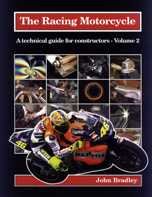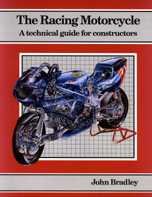The Racing Motorcycle - A Technical Guide for Constructors Volume 2 By John Bradley is now available.
John Bradley's first volume was considered by most to be the best practical guide to modifying or constructing a race bike. Volume 2 picks up where the first volume left off and really goes indepth on the specifics of the practical aspects of building and modifying frames , pipes and more. Everything from building a frame jig to rolling and welding an exhaust cone is covered. Anyone who has ever thought about wedging an XR100 engine in a better frame will find this book to be a wealth of useful and interesting information.
Micheal Moore' s company Euro Spares is the North American Distributor for the books
http://www.eurospares.com/samplepages/howto.htm and his website is a veritable playground for insanely passionate bikers building some of the coolest one off bikes you've ever seen. Even if you have no interest in building or modifying a frame go look around his site and revel in the fun that people are having building stuff in garages and sheds around the world.
An Overview of Both Volumes from the Eurospares website:
Volumes 1 and 2 of ‘The Racing Motorcycle, a technical guide for constructors’ are specifically written for those who wish to build their own race bikes. However, a lot of the information in Volume 1 will appeal to anyone who is simply interested in what makes bikes perform. Similarly, Volume 2 contains much to interest to those building cars and karts as well as bikes.
Volume 1 deals with fundamental performance issues, covering areas such as engine characteristics, gearing and gear ratio suitability, chassis geometry, weight distribution, suspension and aerodynamics. There is also a section discussing straight-line performance, the influence of weight, rotational inertia etc. There are numerous examples and tables of data taken from a variety of successful bikes. In essence, Volume 1 provides a performance overview and identifies things that need to be thought about before spending significant sums of money.
Volume 2 assumes you have formulated a design concept and are going to construct your own rolling chassis. It discusses numerous technical and practical issues but is primarily focused on the various engineering materials that are employed. This book covers all the materials normally used for motorcycle construction, eg steels, aluminium, magnesium and titanium alloys, plastics, composites, and a variety of more specialised alloys.
This is not a text book and there is a constant practical theme running through the book, along with numerous contact details for suppliers, fabricators etc. There are over 300 photographs illustrating the way things are done. A significant part of the book deals with structural issues such as strength and stiffness, how to minimise structural failures etc. This coverage is non-mathematical so that every constructor can benefit from it, whatever their background.
Volume 2 does not cover those issues that are adequately covered by monthly magazines, things like making up brake hoses or where to buy standard motorcycle parts. Instead it concentrates on the engineering issues that are of vital importance but rarely discussed in depth.
To see some sample pages of both books http://www.eurospares.com/samplepages/rmindex.htm
While you are at the Eurospares site take a look at Tony Foale's book "Motorcycle Handling and Chassis Design" . It's another must have book for anyone who wants to understand what makes a bike chassis work.
http://www.eurospares.com/tfoale/book/book.htm
John Bradley's first volume was considered by most to be the best practical guide to modifying or constructing a race bike. Volume 2 picks up where the first volume left off and really goes indepth on the specifics of the practical aspects of building and modifying frames , pipes and more. Everything from building a frame jig to rolling and welding an exhaust cone is covered. Anyone who has ever thought about wedging an XR100 engine in a better frame will find this book to be a wealth of useful and interesting information.
Micheal Moore' s company Euro Spares is the North American Distributor for the books
http://www.eurospares.com/samplepages/howto.htm and his website is a veritable playground for insanely passionate bikers building some of the coolest one off bikes you've ever seen. Even if you have no interest in building or modifying a frame go look around his site and revel in the fun that people are having building stuff in garages and sheds around the world.
An Overview of Both Volumes from the Eurospares website:
Volumes 1 and 2 of ‘The Racing Motorcycle, a technical guide for constructors’ are specifically written for those who wish to build their own race bikes. However, a lot of the information in Volume 1 will appeal to anyone who is simply interested in what makes bikes perform. Similarly, Volume 2 contains much to interest to those building cars and karts as well as bikes.
Volume 1 deals with fundamental performance issues, covering areas such as engine characteristics, gearing and gear ratio suitability, chassis geometry, weight distribution, suspension and aerodynamics. There is also a section discussing straight-line performance, the influence of weight, rotational inertia etc. There are numerous examples and tables of data taken from a variety of successful bikes. In essence, Volume 1 provides a performance overview and identifies things that need to be thought about before spending significant sums of money.
Volume 2 assumes you have formulated a design concept and are going to construct your own rolling chassis. It discusses numerous technical and practical issues but is primarily focused on the various engineering materials that are employed. This book covers all the materials normally used for motorcycle construction, eg steels, aluminium, magnesium and titanium alloys, plastics, composites, and a variety of more specialised alloys.
This is not a text book and there is a constant practical theme running through the book, along with numerous contact details for suppliers, fabricators etc. There are over 300 photographs illustrating the way things are done. A significant part of the book deals with structural issues such as strength and stiffness, how to minimise structural failures etc. This coverage is non-mathematical so that every constructor can benefit from it, whatever their background.
Volume 2 does not cover those issues that are adequately covered by monthly magazines, things like making up brake hoses or where to buy standard motorcycle parts. Instead it concentrates on the engineering issues that are of vital importance but rarely discussed in depth.
To see some sample pages of both books http://www.eurospares.com/samplepages/rmindex.htm
While you are at the Eurospares site take a look at Tony Foale's book "Motorcycle Handling and Chassis Design" . It's another must have book for anyone who wants to understand what makes a bike chassis work.
http://www.eurospares.com/tfoale/book/book.htm

